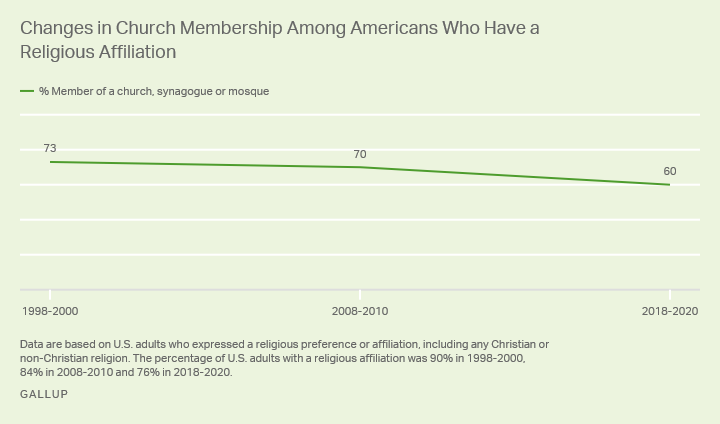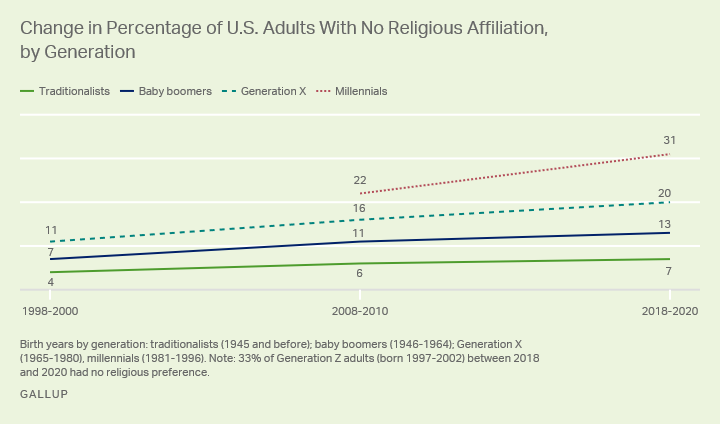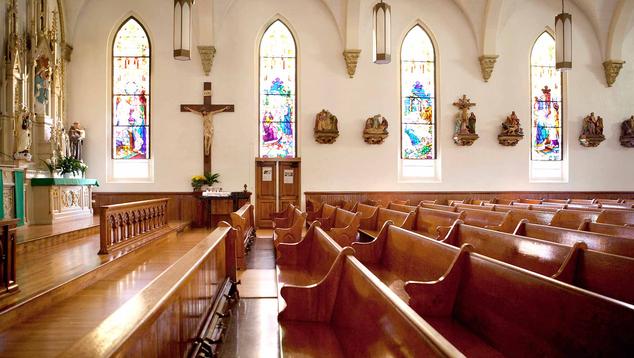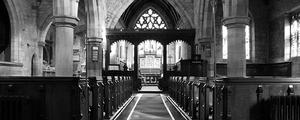Story Highlights
- In 2020, 47% of U.S. adults belonged to a church, synagogue or mosque
- Down more than 20 points from turn of the century
- Change primarily due to rise in Americans with no religious preference
WASHINGTON, D.C. -- Americans' membership in houses of worship continued to decline last year, dropping below 50% for the first time in Gallup's eight-decade trend. In 2020, 47% of Americans said they belonged to a church, synagogue or mosque, down from 50% in 2018 and 70% in 1999.

Line graph. U.S. church membership was 73% in 1937 when Gallup first measured it. It stayed near 70% through 2000 before beginning to decline, to 61% in 2010 and 47% in 2020.
U.S. church membership was 73% when Gallup first measured it in 1937 and remained near 70% for the next six decades, before beginning a steady decline around the turn of the 21st century.
As many Americans celebrate Easter and Passover this week, Gallup updates a 2019 analysis that examined the decline in church membership over the past 20 years.
Gallup asks Americans a battery of questions on their religious attitudes and practices twice each year. The following analysis of declines in church membership relies on three-year aggregates from 1998-2000 (when church membership averaged 69%), 2008-2010 (62%), and 2018-2020 (49%). The aggregates allow for reliable estimates by subgroup, with each three-year period consisting of data from more than 6,000 U.S. adults.
Decline in Membership Tied to Increase in Lack of Religious Affiliation
The decline in church membership is primarily a function of the increasing number of Americans who express no religious preference. Over the past two decades, the percentage of Americans who do not identify with any religion has grown from 8% in 1998-2000 to 13% in 2008-2010 and 21% over the past three years.
As would be expected, Americans without a religious preference are highly unlikely to belong to a church, synagogue or mosque, although a small proportion -- 4% in the 2018-2020 data -- say they do. That figure is down from 10% between 1998 and 2000.
Given the nearly perfect alignment between not having a religious preference and not belonging to a church, the 13-percentage-point increase in no religious affiliation since 1998-2000 appears to account for more than half of the 20-point decline in church membership over the same time.
Most of the rest of the drop can be attributed to a decline in formal church membership among Americans who do have a religious preference. Between 1998 and 2000, an average of 73% of religious Americans belonged to a church, synagogue or mosque. Over the past three years, the average has fallen to 60%.

Line graph. Changes in church membership among Americans who express a religious preference or affiliation. Between 1998 and 2000, 73% of religious Americans were members of a church, synagogue or mosque. That dipped to 70% between 2008 and 2010, and it fell to 60% between 2018 and 2020.
Generational Differences Linked to Change in Church Membership
Church membership is strongly correlated with age, as 66% of traditionalists -- U.S. adults born before 1946 -- belong to a church, compared with 58% of baby boomers, 50% of those in Generation X and 36% of millennials. The limited data Gallup has on church membership among the portion of Generation Z that has reached adulthood are so far showing church membership rates similar to those for millennials.
The decline in church membership, then, appears largely tied to population change, with those in older generations who were likely to be church members being replaced in the U.S. adult population with people in younger generations who are less likely to belong. The change has become increasingly apparent in recent decades because millennials and Gen Z are further apart from traditionalists in their church membership rates (about 30 points lower) than baby boomers and Generation X are (eight and 16 points, respectively). Also, each year the younger generations are making up an increasingly larger part of the entire U.S. adult population.
Still, population replacement doesn't fully explain the decline in church membership, as adults in the older generations have shown roughly double-digit decreases from two decades ago. Church membership is down even more, 15 points, in the past decade among millennials.
| 1998-2000 | 2008-2010 | 2018-2020 | Change since 1998-2000 |
||||||||||||||||||||||||||||||||||||||||||||||||||||||||||||||||||||||||||||||||||||||||||||||||
|---|---|---|---|---|---|---|---|---|---|---|---|---|---|---|---|---|---|---|---|---|---|---|---|---|---|---|---|---|---|---|---|---|---|---|---|---|---|---|---|---|---|---|---|---|---|---|---|---|---|---|---|---|---|---|---|---|---|---|---|---|---|---|---|---|---|---|---|---|---|---|---|---|---|---|---|---|---|---|---|---|---|---|---|---|---|---|---|---|---|---|---|---|---|---|---|---|---|---|---|
| % | % | % | pct. pts. | ||||||||||||||||||||||||||||||||||||||||||||||||||||||||||||||||||||||||||||||||||||||||||||||||
| Traditionalists (born before 1946) | 77 | 73 | 66 | -11 | |||||||||||||||||||||||||||||||||||||||||||||||||||||||||||||||||||||||||||||||||||||||||||||||
| Baby boomers (born 1946-1964) | 67 | 63 | 58 | -9 | |||||||||||||||||||||||||||||||||||||||||||||||||||||||||||||||||||||||||||||||||||||||||||||||
| Generation X (born 1965-1980) | 62 | 57 | 50 | -12 | |||||||||||||||||||||||||||||||||||||||||||||||||||||||||||||||||||||||||||||||||||||||||||||||
| Millennials (born 1981-1996) | n/a | 51 | 36 | n/a | |||||||||||||||||||||||||||||||||||||||||||||||||||||||||||||||||||||||||||||||||||||||||||||||
| Note: Given that Gallup's polls are based on the 18+ U.S. adult population, the 1980-2000 period would have included only a small proportion of the millennial generation, and the 2018-2020 period includes only a small proportion of Generation Z (born after 1996). | |||||||||||||||||||||||||||||||||||||||||||||||||||||||||||||||||||||||||||||||||||||||||||||||||||
| Gallup | |||||||||||||||||||||||||||||||||||||||||||||||||||||||||||||||||||||||||||||||||||||||||||||||||||
The two major trends driving the drop in church membership -- more adults with no religious preference and falling rates of church membership among people who do have a religion -- are apparent in each of the generations over time.
Since the turn of the century, there has been a near doubling in the percentage of traditionalists (from 4% to 7%), baby boomers (from 7% to 13%) and Gen Xers (11% to 20%) with no religious affiliation.

Line graph. Changes in the percentage with no religious identification, by generation. Each generation of U.S adults has seen an increase in the proportion of the generation with no religious preference.
Currently, 31% of millennials have no religious affiliation, which is up from 22% a decade ago. Similarly, 33% of the portion of Generation Z that has reached adulthood have no religious preference.
Also, each generation has seen a decline in church membership among those who do affiliate with a specific religion. These declines have ranged between six and eight points over the past two decades for traditionalists, baby boomers and Generation X who identify with a religious faith. In just the past 10 years, the share of religious millennials who are church members has declined from 63% to 50%.

Line graph. Changes in church membership among those with a religious affiliation, by generation. There has been a seven-point decline in church membership, from 79% in 1998-2000 to 72% now, among traditionalists with a religious preference. There has been a six-point decline over the same period, from 71% to 65%, in church membership among baby boomers with a religious preference. There has been an eight-point decline in church membership among those in Generation X with a religious preference, from 68% to 60%. And there has been a 13-point decline since 2008-2010 among millennials with a religious preference, from 63% to 50%.
Church Membership Decline Seen in All Major Subgroups
As would be expected given the 20-point decline in church membership overall, the Gallup data show declines among all major subgroups of the U.S. population beyond age, with some differences in the size of that decline.
Among religious groups, the decline in membership is steeper among Catholics (down 18 points, from 76% to 58%) than Protestants (down nine points, from 73% to 64%). This mirrors the historical changes in church attendance Gallup has documented among Catholics, with sharp declines among Catholics but not among Protestants. Gallup does not have sufficient data to analyze the trends for other religious faiths.
In addition to Protestants, declines in church membership are proportionately smaller among political conservatives, Republicans, married adults and college graduates. These groups tend to have among the highest rates of church membership, along with Southern residents and non-Hispanic Black adults.
Over the past two decades, declines in church membership have been greater among Eastern residents and Democrats. Still, political independents have lower rates of church membership than Democrats do.
| 1998-2000 | 2008-2010 | 2018-2020 | Change, 1998-2000 to 2018-2020 |
||||||||||||||||||||||||||||||||||||||||||||||||||||||||||||||||||||||||||||||||||||||||||||||||
|---|---|---|---|---|---|---|---|---|---|---|---|---|---|---|---|---|---|---|---|---|---|---|---|---|---|---|---|---|---|---|---|---|---|---|---|---|---|---|---|---|---|---|---|---|---|---|---|---|---|---|---|---|---|---|---|---|---|---|---|---|---|---|---|---|---|---|---|---|---|---|---|---|---|---|---|---|---|---|---|---|---|---|---|---|---|---|---|---|---|---|---|---|---|---|---|---|---|---|---|
| % | % | % | pct. pts. | ||||||||||||||||||||||||||||||||||||||||||||||||||||||||||||||||||||||||||||||||||||||||||||||||
| Men | 64 | 58 | 46 | -18 | |||||||||||||||||||||||||||||||||||||||||||||||||||||||||||||||||||||||||||||||||||||||||||||||
| Women | 73 | 65 | 53 | -20 | |||||||||||||||||||||||||||||||||||||||||||||||||||||||||||||||||||||||||||||||||||||||||||||||
| Non-Hispanic White adults | 68 | 62 | 52 | -16 | |||||||||||||||||||||||||||||||||||||||||||||||||||||||||||||||||||||||||||||||||||||||||||||||
| Non-Hispanic Black adults | 78 | 70 | 59 | -19 | |||||||||||||||||||||||||||||||||||||||||||||||||||||||||||||||||||||||||||||||||||||||||||||||
| College graduate | 68 | 65 | 54 | -14 | |||||||||||||||||||||||||||||||||||||||||||||||||||||||||||||||||||||||||||||||||||||||||||||||
| Not college graduate | 69 | 60 | 47 | -22 | |||||||||||||||||||||||||||||||||||||||||||||||||||||||||||||||||||||||||||||||||||||||||||||||
| Married | 71 | 68 | 58 | -13 | |||||||||||||||||||||||||||||||||||||||||||||||||||||||||||||||||||||||||||||||||||||||||||||||
| Not married | 64 | 55 | 42 | -22 | |||||||||||||||||||||||||||||||||||||||||||||||||||||||||||||||||||||||||||||||||||||||||||||||
| Republican | 77 | 75 | 65 | -12 | |||||||||||||||||||||||||||||||||||||||||||||||||||||||||||||||||||||||||||||||||||||||||||||||
| Independent | 59 | 51 | 41 | -18 | |||||||||||||||||||||||||||||||||||||||||||||||||||||||||||||||||||||||||||||||||||||||||||||||
| Democrat | 71 | 60 | 46 | -25 | |||||||||||||||||||||||||||||||||||||||||||||||||||||||||||||||||||||||||||||||||||||||||||||||
| Conservative | 78 | 73 | 64 | -14 | |||||||||||||||||||||||||||||||||||||||||||||||||||||||||||||||||||||||||||||||||||||||||||||||
| Moderate | 66 | 59 | 45 | -21 | |||||||||||||||||||||||||||||||||||||||||||||||||||||||||||||||||||||||||||||||||||||||||||||||
| Liberal | 56 | 46 | 35 | -21 | |||||||||||||||||||||||||||||||||||||||||||||||||||||||||||||||||||||||||||||||||||||||||||||||
| East | 69 | 58 | 44 | -25 | |||||||||||||||||||||||||||||||||||||||||||||||||||||||||||||||||||||||||||||||||||||||||||||||
| Midwest | 72 | 66 | 54 | -18 | |||||||||||||||||||||||||||||||||||||||||||||||||||||||||||||||||||||||||||||||||||||||||||||||
| South | 74 | 70 | 58 | -16 | |||||||||||||||||||||||||||||||||||||||||||||||||||||||||||||||||||||||||||||||||||||||||||||||
| West | 57 | 51 | 38 | -19 | |||||||||||||||||||||||||||||||||||||||||||||||||||||||||||||||||||||||||||||||||||||||||||||||
| Protestant | 73 | 72 | 64 | -9 | |||||||||||||||||||||||||||||||||||||||||||||||||||||||||||||||||||||||||||||||||||||||||||||||
| Catholic | 76 | 73 | 58 | -18 | |||||||||||||||||||||||||||||||||||||||||||||||||||||||||||||||||||||||||||||||||||||||||||||||
| Gallup | |||||||||||||||||||||||||||||||||||||||||||||||||||||||||||||||||||||||||||||||||||||||||||||||||||
The smaller declines seen among conservatives and other subgroups are largely attributable to more modest change among older generations within those groups. For example, conservatives in older generations have shown drops in church membership of between five and 13 points since 1998-2000, compared with the 20-point change among all U.S. adults. However, the influence of generation is apparent, in that church membership is lower in each younger generation of conservatives than in each older generation -- 51% of conservative millennials, 64% of conservative Gen Xers, 70% of conservative baby boomers and 71% of conservative traditionalists in 2018-2020 belong to a church.
Hispanic Church Membership
Church membership among Hispanic Americans in 2018-2020 was 37%, among the lowest for any major subgroup. Analysis of changes over time in Hispanic adults' church membership is complicated by a shift in Gallup methodology to include Spanish-language interviewing in all surveys beginning in 2011. Church membership rates are significantly lower among Hispanic respondents interviewed in Spanish than among Hispanic respondents interviewed in English. Thus, a comparison of current Hispanic church membership to past membership would overstate the decline by virtue of comparing mixed-language Hispanics today to English-speaking Hispanics, alone, in the earlier period.
Implications
The U.S. remains a religious nation, with more than seven in 10 affiliating with some type of organized religion. However, far fewer, now less than half, have a formal membership with a specific house of worship. While it is possible that part of the decline seen in 2020 was temporary and related to the coronavirus pandemic, continued decline in future decades seems inevitable, given the much lower levels of religiosity and church membership among younger versus older generations of adults.
Churches are only as strong as their membership and are dependent on their members for financial support and service to keep operating. Because it is unlikely that people who do not have a religious preference will become church members, the challenge for church leaders is to encourage those who do affiliate with a specific faith to become formal, and active, church members.
While precise numbers of church closures are elusive, a conservative estimate is that thousands of U.S. churches are closing each year.
A 2017 Gallup study found churchgoers citing sermons as the primary reason they attended church. Majorities also said spiritual programs geared toward children and teenagers, community outreach and volunteer opportunities, and dynamic leaders were also factors in their attendance. A focus on some of these factors may also help local church leaders encourage people who share their faith to join their church.
Learn more about how the Gallup Poll Social Series works.




